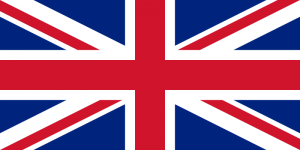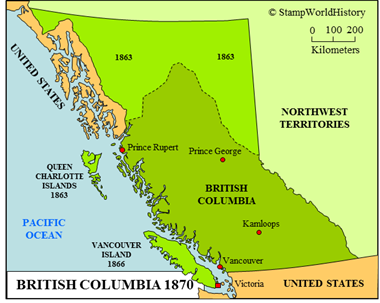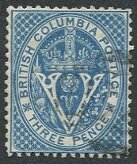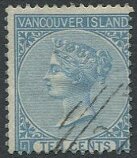
British Columbia & Vancouver Island
Quick reference
General issues: British Columbia & Vancouver Island/Postal union 1860-1865, British Columbia/British colony 1865-1868, Vancouver Island/British colony 1865-1868, British Columbia & Vancouver Island/British colony 1868-1871
Country name on general issues: British Columbia & Vancouver Island, British Columbia, Vancouver Island
Currency: 1 Shilling = 12 Pence 1860-1865, 1 Dollar = 100 Cents 1865-1871
Population: 11 800 in 1861
Political history British Columbia & Vancouver Island
British Columbia and Vancouver Island are located in North America on the Pacific Coast of modern day Canada. Prior to colonization, British Columbia was inhabited by a range of Amerindian peoples – some of these peoples were nomadic hunter gatherers while others led sedentary lives. The first Europeans to explore the coast of British Columbia and Vancouver Island were the Spanish in 1774 – thus asserting the Spanish claim to the Pacific Coast of North America. The British followed soon after. James Cook explored British Columbia and Vancouver Island in 1778 and George Vancouver in 1792-1793. Negotiations between Great Britain and Spain led to Spain ceding its claims to the British in 1794. The United States – established as an independent nation in 1783 – also laid claim to the territory. A joint administration was agreed upon in 1818. In the south, the border with the United States was agreed upon in 1846. The border with Alaska was defined in a separate treaty in 1903.
Initially, British presence was limited to travelling fur traders from the Hudson’s Bay Company. The first permanent settlement was Victoria on Vancouver Island, established in 1843. Vancouver Island became a colony in 1849. The discovery of gold on the mainland caused a gold rush that brought many gold seekers to British Columbia. For the British to be able to properly administer this influx of people, the colony of British Columbia was established on the mainland in 1858. In subsequent years, the territory of British Columbia was extended on the mainland to the north and by the attachment of the Queen Charlotte Islands to the colony. In 1866 British Columbia and Vancouver Island were amalgamated to form the colony of British Columbia & Vancouver Island. The colony would join the federal Dominion of Canada in 1871 as the province of British Columbia, which it is until today.
Having been dependent on the fur trade, the gold rush – although it ended in 1865 – had led to more permanent settlements and diversification of small scale economic activities. It would not be until the 20th century, though, that British Columbia developed into what is now the fourth Canadian province in terms of GDP and the third in terms of population.
Postal history British Columbia & Vancouver Island
British Columbia and Vancouver Island issued their first stamps as a postal union in 1860. One stamp was issued in a denomination of 2½ pence, showing the portrait of Queen Victoria and inscribed ‘British Columbia & Vancouver Island’. Interesting: the stamp was sold, without overprint, in Vancouver Island for 5 cents, after the dollar had been introduced in 1862, and for 3 pence in British Columbia, after the postal rates had been changed in 1864. In 1865 British Columbia and Vancouver Island individually issued stamps denominated in cents. The British Columbia issues show the seal of the colony while the Vancouver Island issues show the portrait of Queen Victoria. These stamps were used until stamps of British Columbia were issued, overprinted with new denominations in 1868 and 1869 for use throughout what was then the amalgamated colony of British Columbia & Vancouver Island. All stamps discussed, rank in the high to very high catalog value ranges. The stamps of British Columbia & Vancouver Island were superseded by the issues of the Dominion of Canada in 1871.
Album pages
← Previous page: Canada - DominionNext page: Canadian Provinces - Canada →




